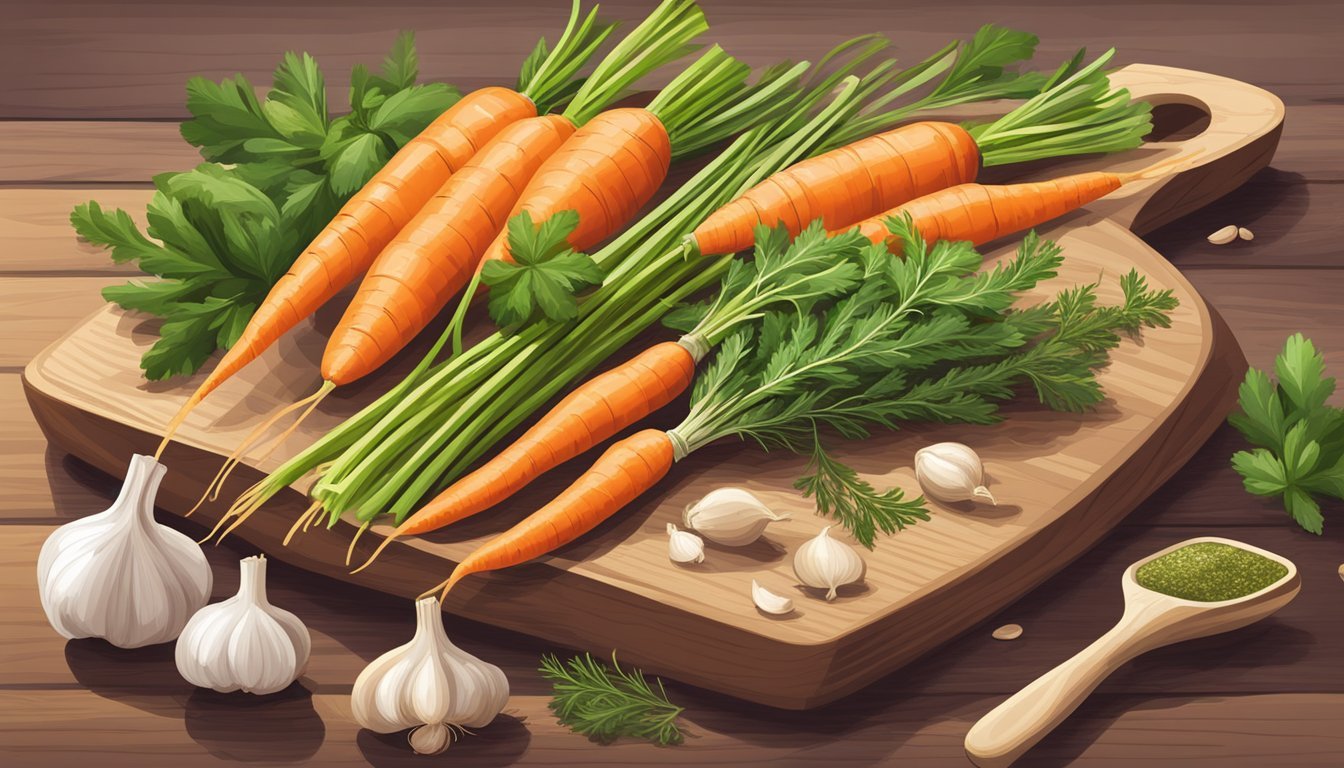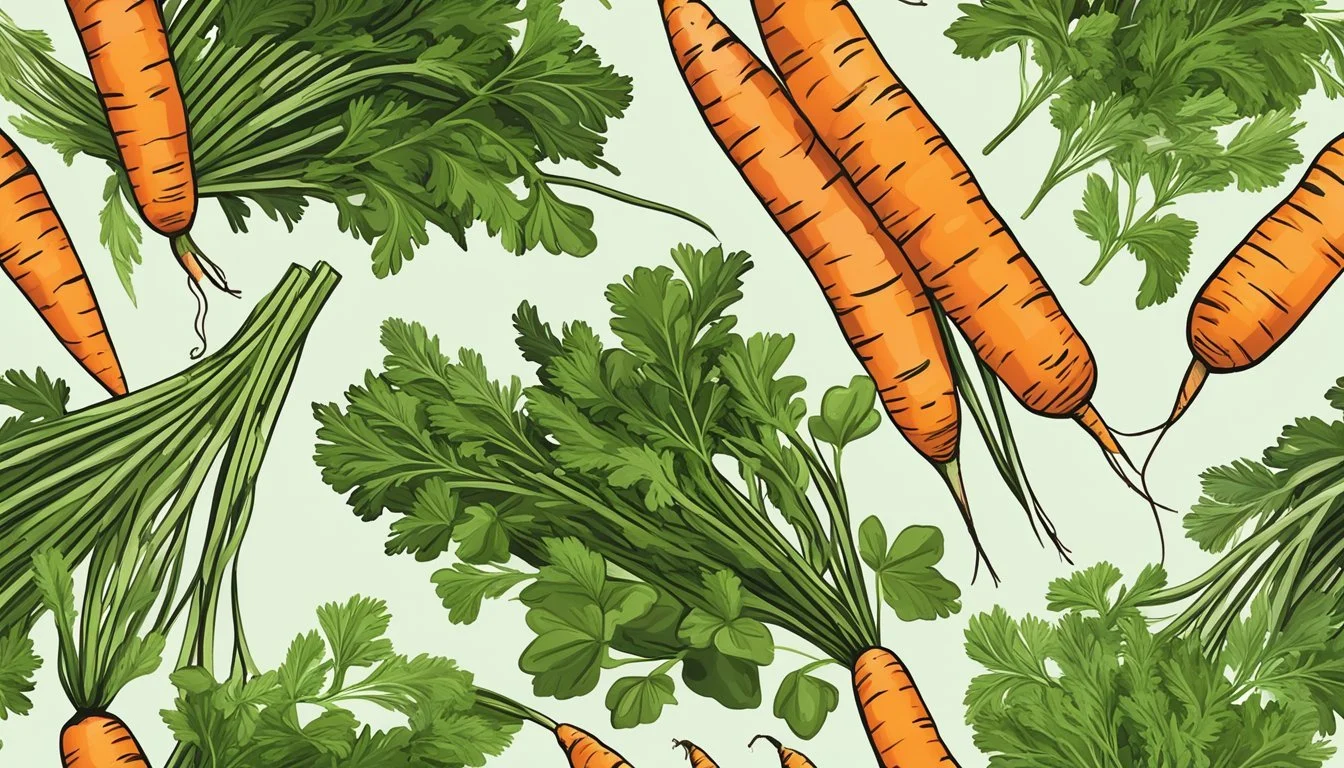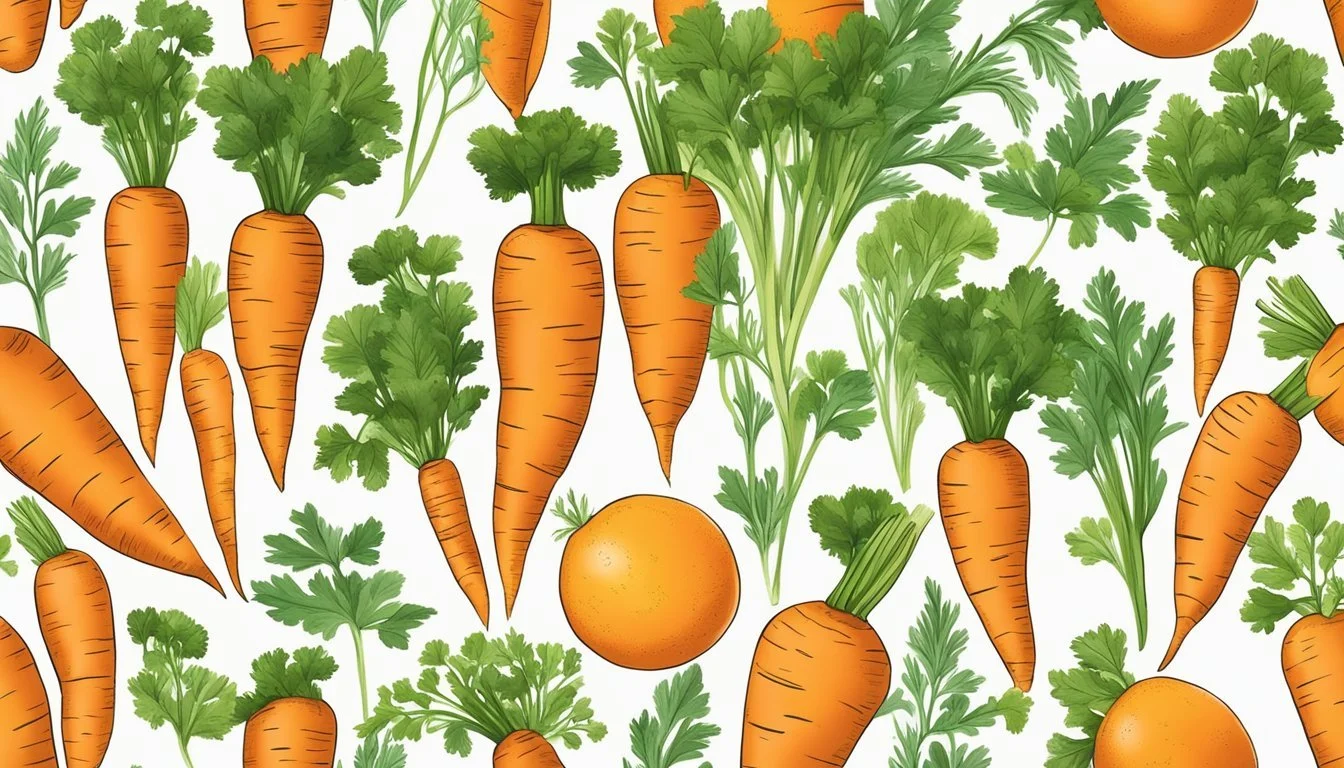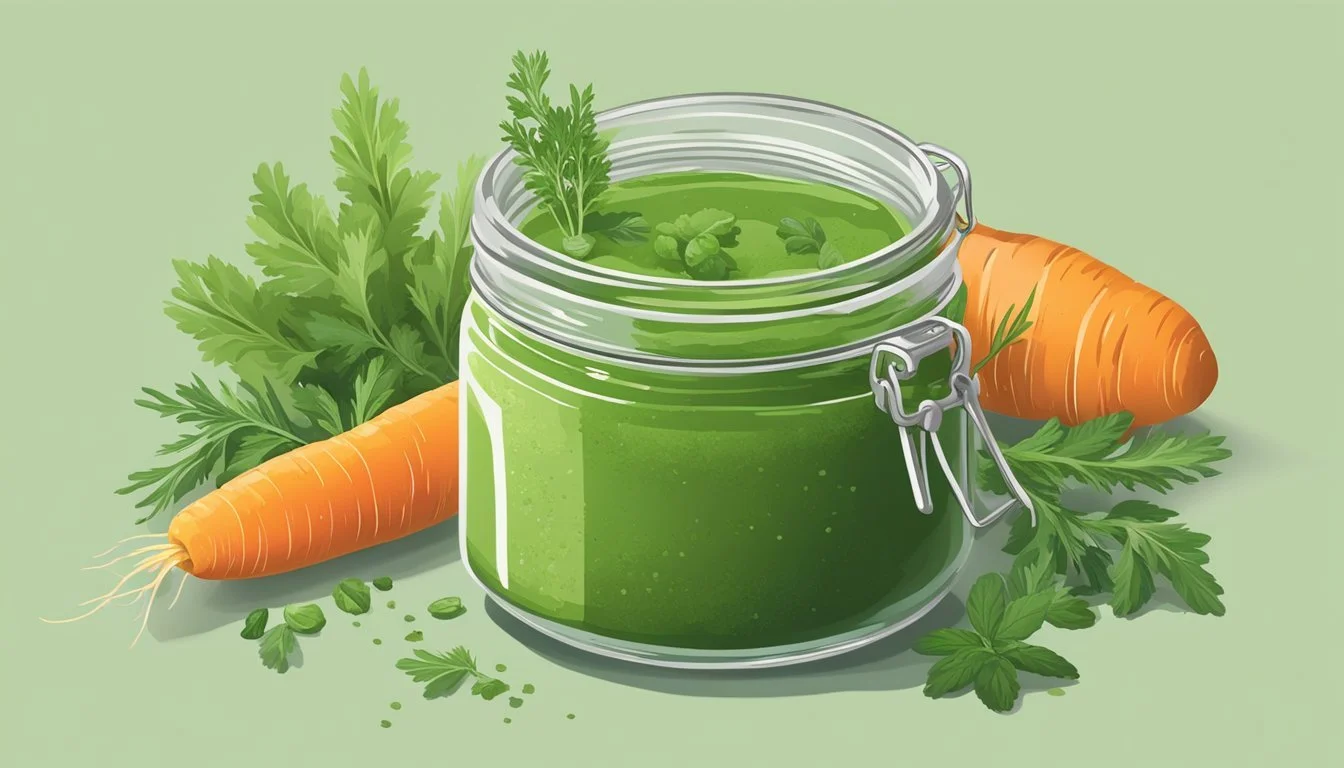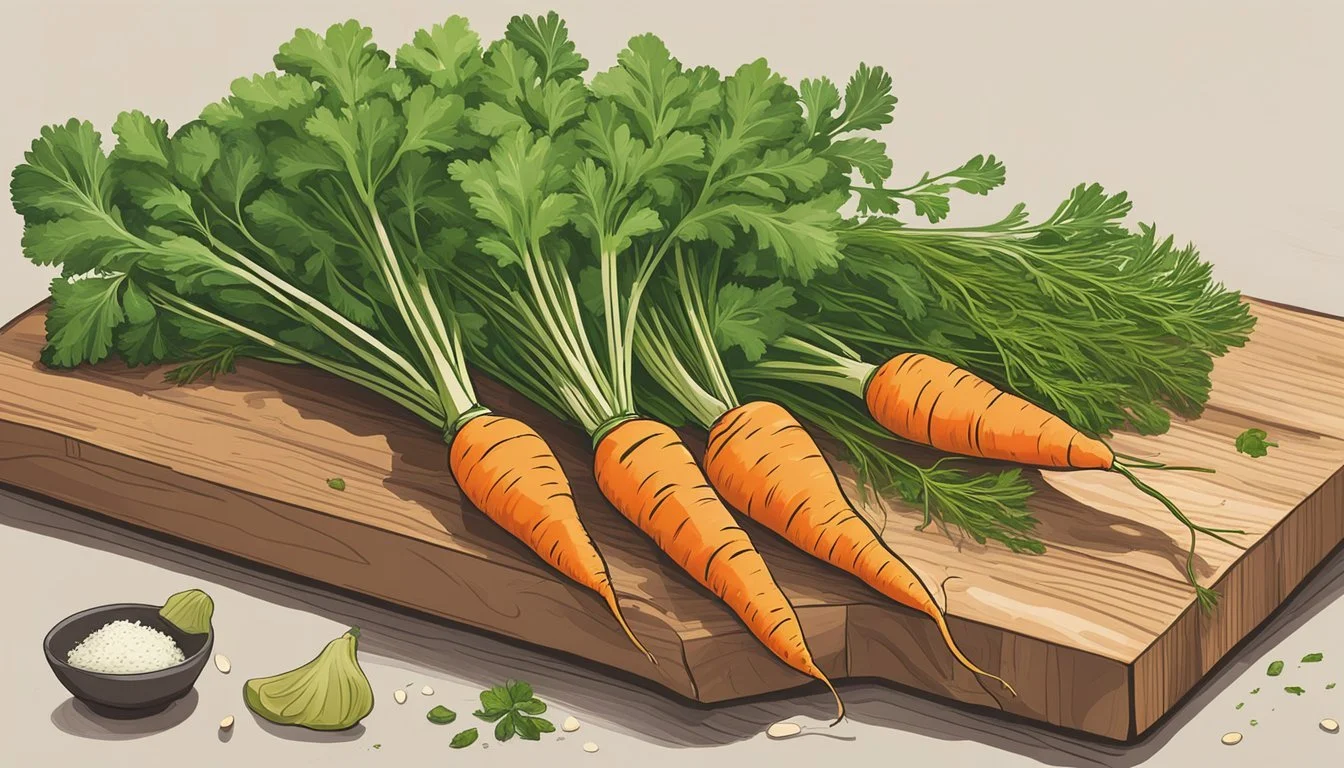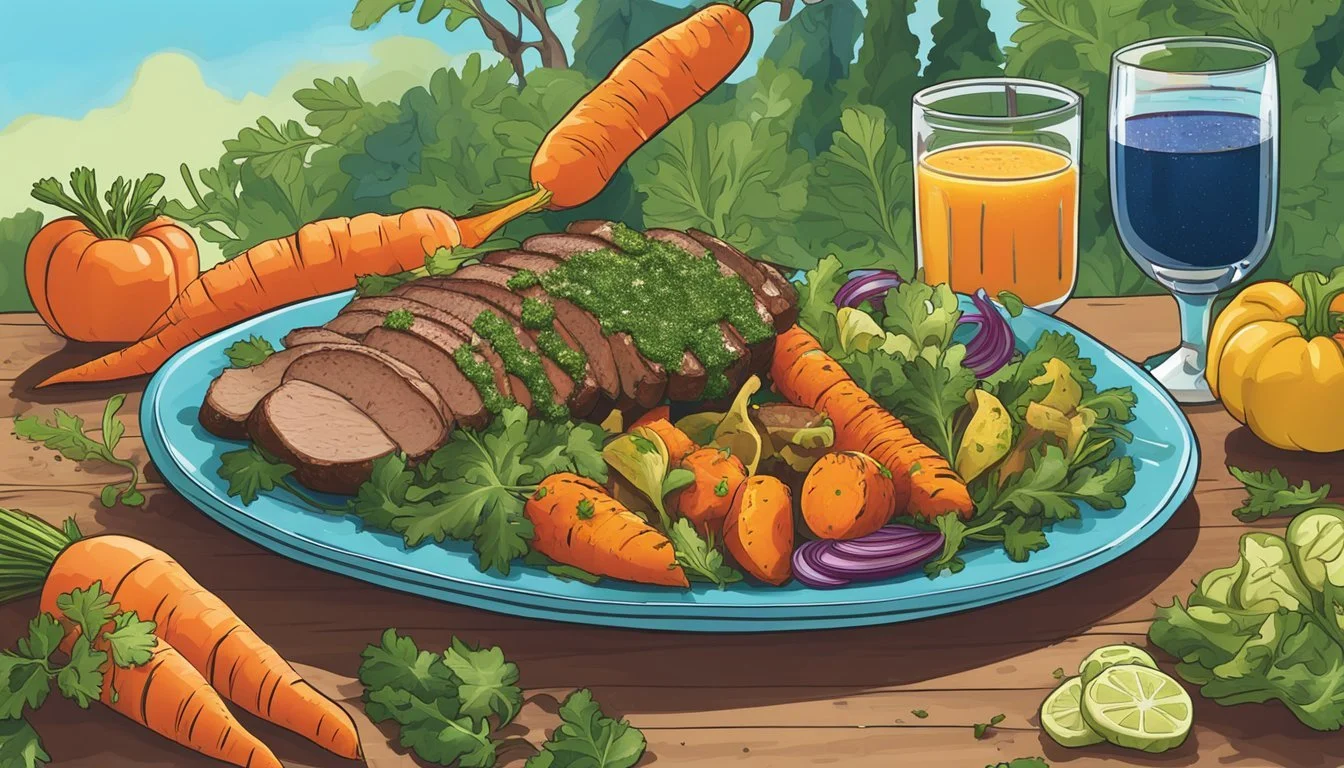Carrot Top Chimichurri
Elevating Flavors with a Sustainable Twist
Carrot Top Chimichurri is a vibrant and herbaceous sauce that challenges the conventional use of herbs in the kitchen. With a focus on sustainability and reducing food waste, this versatile condiment turns the often-discarded greens of carrots into the star ingredient. Carrot tops boast a robust and slightly bitter flavor that, when balanced with the right ingredients, can enliven a variety of dishes.
The sauce itself is anchored by the finely chopped greens of carrots, which are combined with key elements such as garlic, olive oil, and red wine vinegar. The piquancy of the garlic and the acidity of the vinegar cut through the bitterness of the carrot tops, creating a harmonious blend. Additional spices and seasonings, including red pepper flakes, oregano, and salt, contribute to the sauce's bold flavor profile.
As a condiment, carrot top chimichurri serves as a flavorful complement to proteins like steak and seafood and adds a burst of freshness when drizzled over roasted vegetables. (What wine goes well with roasted vegetables?) Its preparation is a testament to the innovative use of all parts of produce, encouraging culinary creativity while supporting more sustainable cooking practices.
The Origin of Chimichurri
Chimichurri is an indispensable accompaniment in Argentine and Uruguayan cuisine, often paired with grilled meats (What wine goes well with grilled meats?) and known for its vibrant color and flavor.
Chimichurri's Birthplace
Chimichurri sauce is deeply rooted in the culinary tradition of Argentina and Uruguay. While its exact birthplace is a matter of national pride and debate, most stories credit Argentina as the origin. The sauce's name isn't linked to any particular Argentine term or story, and lore suggests it may come from a mispronunciation of "Jimmy's curry" by British immigrants after the country's independence.
Culinary History
The history of chimichurri is intertwined with the gauchos, the region's iconic horsemen and cattle herders. They are often credited with the creation or popularization of the sauce, using available ingredients to enhance the flavors of their meat. Authentic chimichurri is a simple mix of parsley, garlic, oil, vinegar, and various seasonings. Contrary to some beliefs, it bears no relation to pesto, despite occasional visual similarities.
Argentine chimichurri does not contain nuts or cheese, unlike its Mediterranean counterpart, and instead incorporates a blend of locally-sourced herbs and spices reflecting the essence of the South American palate.
Nutritional Value
Carrot top chimichurri is not only vibrant in flavor but also rich in nutrients, offering a variety of health benefits. It's a vegan, gluten-free sauce that utilizes the often-discarded greens of carrots.
Health Benefits of Carrot Tops
Carrot tops contain an impressive array of vitamins and minerals. They are particularly high in vitamin C, which is essential for immune function, and vitamin K, important for blood clotting. The greens are also a source of potassium and calcium, contributing to better bone and heart health. Their high fiber content aids in digestion and helps to maintain a healthy gut.
Macro-nutrient Profile
In terms of macronutrients, carrot tops are low in calories yet provide a decent amount of protein and fiber. They possess minimal fat and have no cholesterol, making them heart-healthy. Below is a general macro-nutrient profile for carrot tops:
Calories: Low
Protein: Moderate
Fiber: High
Fat: Low
Cholesterol: None
Carrot tops, when used in making chimichurri, contribute to a nutritious sauce that complements various dishes while adding a significant nutritional boost.
Ingredients Breakdown
Carrot Top Chimichurri relies on a harmonious blend of fresh herbs, pungent garlic, and tangy vinegar, accentuated with quality olive oil and seasoned precisely. Understanding each component helps in crafting a sauce of remarkable flavor.
Primary Components
Carrot Tops: The star ingredient, usually discarded, carrot tops bring a grassy, slightly sweet flavor. They should be washed thoroughly.
Parsley: Adds a bright, fresh taste and complements the carrot tops.
Garlic: It introduces a sharp, spicy note that's essential to chimichurri.
Olive Oil: Acts as a base, with extra virgin olive oil providing a fruity, peppery backbone.
Vinegar: Red wine vinegar is traditional, imparting a tangy contrast to the rich oil and earthy herbs.
Additional Flavors
Oregano: This herb contributes an earthy, slightly bitter undertone.
Chili or Red Pepper Flakes: These add a gentle heat. Adjust to preference.
Salt and Pepper: Enhance and balance the sauce's flavors.
Substitutes and Variations
Vinegar: Lemon juice or a different type of vinegar can be used for variation in acidity.
Herbs: Basil or cilantro can replace or complement parsley for a different profile.
Oil: For a twist, try different oils like avocado for their unique flavors.
Preparation Techniques
To craft an exquisite Carrot Top Chimichurri, one must combine fresh ingredients with specific techniques to achieve the desired flavor and texture. These methods ensure a balanced sauce while promoting sustainability by reducing food waste.
Making the Base Chimichurri
The base of the chimichurri is created using finely-chopped fresh herbs, typically parsley, along with minced garlic for pungency. Ingredients such as red wine vinegar and olive oil are essential for the tang and smoothness of the sauce. These components are usually combined in a food processor for consistency, with the following steps:
Chop: Finely chop the parsley using a food processor or knife.
Mince: Mince fresh garlic cloves.
Mix: In a bowl, mix the herbs and garlic with olive oil and vinegar.
Incorporating Carrot Tops
Carrot tops bring a unique earthiness to the chimichurri and make use of often-discarded greens. To incorporate carrot tops effectively:
Select and Wash: Select fresh, vibrant carrot tops and wash thoroughly.
Chop: Finely chop the carrot tops, either by hand or with a food processor for a more uniform texture.
Combine: Gently fold the chopped carrot tops into the base chimichurri mix.
Texture and Consistency Adjustments
To finalize the sauce, adjust the texture and consistency to personal preference:
Oil: Slowly drizzle in additional olive oil, stirring continuously, to achieve a looser consistency.
Acidity: Balance the flavors with a touch more vinegar if required.
Season: Taste and season with salt, pepper, and optional red pepper flakes as needed.
Prep time for the sauce is minimal, and the total time from start to finish is a matter of minutes, offering a simple yet sophisticated addition to various dishes.
Flavor Profile and Pairings
Carrot top chimichurri offers a unique combination of zesty and earthy tones, making it a versatile condiment for a variety of dishes. It is particularly adept at enhancing the natural flavors of meats and vegetables with its vibrant and herbaceous character.
Taste Exploration
Carrot top chimichurri harnesses the bold flavor of carrot greens, delivering an earthy and slightly bitter taste. These greens are accented with garlic and red pepper flakes, which contribute to the sauce's piquancy and depth. The acidic brightness of red wine vinegar balances the strong notes, while oregano adds a classic herbaceous layer. This combination of flavors transforms a simple sauce into a complex and refreshing culinary experience, aligning perfectly with the natural savoriness of many proteins and vegetables.
Optimal Food Combinations
Carrot top chimichurri works harmoniously with a spectrum of ingredients:
Meats: The vibrant acidity cuts through the richness of beef steaks and pork, while complementing the subtle flavors of chicken and fish.
Vegetables: Drizzled over roasted vegetables, it enhances their natural sweetness and adds a refreshing contrast.
Seafood: A dollop on seafood brightens and ties together the dish's various elements.
Eggs: Spooned over eggs, the sauce adds zest and makes for a compelling taste combination.
Salads: When used as a dressing, it intensifies the fresh, green flavors of a salad, making each bite more lively.
Here's an at-a-glance pairing guide:
Ingredient Pairing Note Beef Steak Adds zest, complements meat's richness Pork Cuts through fat, adds freshness Chicken Elevates subtle flavor with herby notes Fish Brightens delicate seafood flavors Roasted Vegetables Enhances sweetness, adds complexity Eggs Introduces a bold flavor contrast Salads Accentuates green, fresh qualities
Whether it serves as a marinade, a condiment, or a dressing, carrot top chimichurri is adaptable and enhances a variety of dishes with its distinct flavor profile.
Serving Suggestions
Carrot top chimichurri serves as a vibrant condiment that can transform a variety of dishes with its fresh, herbaceous flavor. It's versatile and can be used quite liberally or sparingly, depending on the meal and personal preference.
Dish Enhancements
Grilled Meats: A spoonful of chimichurri on top of grilled steak or chicken adds a zesty tang.
Roasted Vegetables: Drizzle over roasted potatoes or a medley of seasonal vegetables for an extra burst of flavor.
Salads: Mix into a kale or mixed greens salad as a lively dressing alternative.
Sandwiches: Spread on bread or dab onto burgers to elevate the taste beyond the ordinary.
Portion Sizes and Presentation
Condiment Bowl: Serve 2-3 tablespoons per person in a small bowl for individual garnishing.
Direct Application: Spoon the sauce directly over dishes, allowing the bright green color to stand out visually.
Salsa Alternative: Offer it as a more herbaceous substitute to traditional salsa for dipping.
Remember, the key is to use the sauce to complement the main flavors of the dish, not to overpower them.
Storage and Preservation
Proper storage of Carrot Top Chimichurri is critical to maintaining its bright and fresh flavor. Whether one requires short-term solutions for immediate use or seeks long-term storage techniques to extend the life of their sauce, understanding the appropriate methods is key.
Short-term Solutions
For those looking to enjoy their Chimichurri within a week, refrigeration is the simplest method. Freshly made Chimichurri should be placed in an airtight container or tightly sealed jar and stored in the refrigerator. This method will preserve the sauce's vibrant color and rich flavor, with optimal use within:
5 to 7 days for the best quality
3 days for the most intense fresh oregano flavor
Long-term Storage Techniques
To extend the Chimichurri’s shelf life beyond a week, freezing is an effective option. One should portion the sauce into ice cube trays or small freezer bags to freeze; this allows for easy defrosting and use in the future. It is important to note that while freezing can maintain the integrity of the sauce for several months, some slight changes in texture may occur once thawed. The recommended freezer storage time is:
Up to 2 months for peak quality
Utilization of vacuum sealing can further extend storage while protecting the fresh flavor.
By employing these storage solutions, Carrot Top Chimichurri can remain a delightful addition to meals, preserving its fresh and herby essence for future enjoyment.
Culinary Uses Beyond Chimichurri
Carrot top chimichurri is just the starting point. These leafy greens can elevate a variety of dishes, turning simple ingredients into gourmet experiences. They can also help reduce food waste by transforming what might be discarded into the centerpiece of a meal.
Versatile Applications in Cooking
The use of carrot tops extends beyond the traditional chimichurri; they can bring a fresh and earthy flavor to many dishes. For instance, blending carrot tops into a pesto provides a flavorful companion to pastas and breads. Simple ingredients like garlic, olive oil, and nuts, such as walnuts for a walnut pesto, pair well with the slight bitterness of the greens. Carrot tops can also be incorporated into a salad to add a unique taste and texture, complementing lettuces and other leafy greens with their robust flavor.
Innovative Recipe Ideas
Carrot greens can replace parsley or cilantro leaves in nearly any recipe to add zest while reducing food waste. Experiment with roasted veggies by tossing them in a carrot top-infused oil, or add chopped carrot tops to a sweet potato hash for breakfast. The greens can be a bright addition to grain-based dishes, giving a nutritional boost to quinoa or couscous (What wine goes well with couscous?) salads. To capture the spirit of chimichurri, one might drizzle a carrot top dressing over grilled steak or salmon, accentuating the dish with the freshness of herbs and the tang of lemon juice or lime.
Fusions and Crossovers
Carrot tops are a versatile base for creating fusion dishes that cross cultural boundaries. Incorporating them into a vegan aioli with a touch of kosher salt and lemon juice could yield an impressive topping for sandwiches or a creative dip for fries. Their hardy texture holds up well, making them an excellent candidate for innovative salsas or relishes that could accompany a range of proteins from grilled chicken to baked tofu.
Environmental Impact and Sustainability
Creating Carrot Top Chimichurri is not just a culinary innovation, but it's also a step towards more sustainable cooking practices. This section elucidates how incorporating carrot tops in recipes can minimize food waste and support sustainable gardening.
Reducing Food Waste with Carrot Tops
Carrot tops are often discarded, contributing significantly to food waste. Utilizing these greens in a Carrot Top Chimichurri sauce can effectively reduce this waste, as carrot tops are edible and nutritious. By incorporating carrot tops into a flavorful sauce, households and restaurants alike can decrease the volume of organic waste sent to landfills. In turn, this practice lessens methane emissions from decomposing vegetables, thereby reducing their environmental impact.
Benefits:
Prevents edible greens from being thrown away.
Reduces greenhouse gas emissions associated with food waste decomposing in landfills.
Sustainable Gardening and Harvesting
Adopting sustainable gardening practices, such as growing carrots and using the entire plant including the tops, contributes to a circular and sustainable food system. By picking carrots from a CSA (Community Supported Agriculture) or a home garden, one can ensure that all parts of the plants are used or composted, promoting a zero-waste approach. This method of harvesting also supports local agriculture and reduces the carbon footprint associated with transporting vegetables over long distances.
Methods:
Joining a CSA to acquire fresh vegetables with less packaging.
Growing carrots at home to ensure the entire plant's use, enhancing sustainability.
By using carrot tops, an often-overlooked ingredient, in making Chimichurri, individuals can contribute to reducing food waste while enjoying an herbaceous and vibrant sauce. This practice advocates for a more mindful use of resources and a commitment to sustainability.
Side Dishes and Accompaniments
Carrot Top Chimichurri's vibrant flavor pairs exceptionally well with a wide array of side dishes, ranging from roasted vegetables to hearty grains. Selecting the right accompaniments can enhance both the taste and presentation of the meal.
Complementary Vegetables
Roasted Carrots:
Preparation: Tossed in olive oil, seasoned with salt and pepper, and roasted until tender enhances their natural sweetness, making a fitting contrast to the chimichurri's zest.
Asparagus:
Preparation: Lightly grilled or roasted with a touch of garlic, these spears add an elegant and fresh side option that complements the herby notes of the chimichurri.
Starchy Sides and Legumes
Potatoes:
Roasted Baby Potatoes: Halving and roasting these potatoes in olive oil and rosemary until crispy can be a deliciously simple pairing.
Lemon Couscous: The lemon's bright acidity can balance the chimichurri's bold flavors, creating a harmonious dish.
Beans:
Baked Beans: A classic, savory side that can serve as a sweet and tangy balance to the piquant sauce.
Spinach Mushroom Quinoa: Incorporating sautéed spinach and mushrooms into fluffy quinoa creates a nutritious and satisfying accompaniment.
Tips and Tricks
Creating an exceptional Carrot Top Chimichurri relies not only on the ingredients but also on technique and problem-solving. Below are detailed tips and suggestions for perfecting the sauce and troubleshooting issues that might arise.
Expert Advice for Perfect Chimichurri
Texture and Flavor Balance:
It's essential to chop the carrot tops and herbs as finely as possible for a uniform texture. Some prefer to chop by hand to control the fineness, but a food processor can be used with caution to avoid turning the sauce into a puree.
The acid component, often red wine vinegar, is key; it should brighten the sauce without overpowering the freshness of the herbs. Lemon juice is a viable substitute for a citrusy twist.
Ingredient Proportions:
A standard ratio to follow is 3 parts oil to 1 part acid. Adjust according to taste and desired consistency.
Use fresh dried oregano sparingly to complement the carrot tops without dominating the flavor profile.
Complementary Pairings:
Seafood, especially grilled fish or shrimp, marries well with the herby and slightly spicy notes of Carrot Top Chimichurri.
A pinch of red chili flakes can add a subtle kick. Balance the heat according to the dish it accompanies.
Troubleshooting Common Issues
Sauce Too Bitter:
Bitterness can occur if the carrot greens are not fresh or too mature. Make sure to use the freshest greens possible.
If the sauce tastes bitter, balancing it with a little more acid or salt can help mask the bitterness.
Lack of Flavourful Punch:
Ensure the garlic is finely minced to release its full flavor, potentially lost if the pieces are too large.
Don't underestimate the power of salt. It enhances all the other flavors in the sauce and should be adjusted carefully to taste.
Separation After Storage:
Separation is normal; simply give the Chimichurri a good stir before serving.
Store in a tightly sealed container in the refrigerator to maintain freshness. Use within a few days for the best quality.
Glossary of Terms
To best understand the recipe for carrot top chimichurri, it is important to familiarize oneself with the various ingredients and culinary expressions associated with this vibrant condiment.
Key Ingredients and Terms
Parsley: An herb commonly found in carrot top chimichurri, offering a fresh and slightly peppery flavor.
Oregano: A robust herb with an earthy and slightly bitter taste, enhancing the complexity of the sauce.
Carrot Greens: The leafy tops of carrots, often discarded, but repurposed in this recipe for their herby and slightly bitter taste.
Herbs: Refers to the leafy greens used in cooking for seasoning; in this context, it includes parsley, oregano, and carrot greens.
Spices: Seasonings derived from seeds, fruits, roots, and bark; specific to this sauce could include cumin, paprika, or red pepper flakes.
Cuisine: Style or method of cooking; carrot top chimichurri is often associated with Argentinean cuisine but is also used in other cultural dishes.
Sauces: Liquid or semi-liquid substances served with food to add moisture and flavor; chimichurri is a type of sauce.
Food: Any nutritious substance eaten to maintain life and growth; in this context, it refers to the dish or meal complemented by carrot top chimichurri.
Recipe: A set of instructions for preparing a particular dish, including a list of the necessary ingredients.
Condiment: A substance such as a sauce or seasoning added to food to impart a particular flavor or to complement the dish.
Culinary Expressions
Chop: A basic cutting method that involves making small cuts in food to reduce its size; often used for preparing the herbs in chimichurri.
Mince: A fine chopping technique, used for garlic in the chimichurri recipe, to ensure its flavor is spread evenly without overpowering.
Combine: The process of mixing two or more ingredients together; in this recipe, it refers to mixing herbs, spices, and liquids to make the chimichurri.
Season: To enhance the flavor of the food by adding spices, herbs, salt, or pepper; crucial in adjusting the taste of the chimichurri to one's preference.
Conclusion
Carrot Top Chimichurri redefines the concept of sustainable gastronomy with a flavorful twist. By transforming the often-discarded carrot tops into the star ingredient of this condiment, it offers a resourceful way to minimize food waste. The distinct herbaceous quality of carrot tops enriches the sauce with a unique taste, distinct from traditional chimichurri made with parsley.
The recipe for Carrot Top Chimichurri is a testament to culinary creativity, encouraging the incorporation of overlooked ingredients into everyday cooking. It has the potential to enhance a variety of dishes, from grilled meats to roasted vegetables, with its vibrant flavor profile. The simple preparation process also makes this condiment accessible to cooks of all skill levels.
Sustainability: Utilizing carrot tops contributes to a more sustainable kitchen.
Flavor: Carrot greens offer a fresh and slightly earthy flavor.
Versatility: Ideal as a marinade, topping, or side for a vast array of dishes.
Finally, Carrot Top Chimichurri is an emblem of the dynamic, evolving nature of modern cuisine, where one can juxtapose flavor with environmental consciousness. It's a prime example that with a bit of ingenuity, one can transform the simplest ingredients into a gourmet experience, while also doing their part for the planet.


